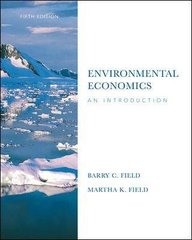Question
Please read the transcript video below and submit an original (inyourownwords) synopsis/commentary of what you viewed. Submissions must be 150-250words . Be sure to include
Please read the transcript video below and submit an original (inyourownwords) synopsis/commentary of what you viewed. Submissions must be 150-250words. Be sure to include at least one specific principle from this week's chapter coverage as you see it illustrated in the video. (You don't have to reference a principle from each chapter-just tie the video concepts back to something you recognize from the text/PowerPoint content for the week). Chapter 21 discusses the Monetary System in detail. Inyourownwords,explainthe role of the Federal Reserve (the Fed)?How much discretion should the Fed have?Should the Fed try to fine-tune the economy or simply keep money supply growing at a steady pace?Why?
And now a brief lesson on the Federal Reserve System, the Federal Reserve or the Fed is the central bank of the United States as the central bank, it determines our nation's monetary policy. This means the Fed determines how much money is floating around in the US economic ecosystem ready to be spent on goods or services. By controlling the money supply, the Fed is able to influence both interest rates and the health of the overall economy. The Fed's goal is to keep two important economic metrics in check unemployment and inflation. The Federal Reserve has a few tools to influence the economy, but its primary focus is the federal funds rate. This is the rate banks use when they lend to one another. Let's look at how this works. Banks are required to keep a certain amount of customer deposits on hand. This is called the reserve requirement and is set by the Fed. If a bank is short one night, it'll call another bank and borrow money so it can meet the requirement by influencing this interbank rate. The Fed also influences other short term rates. Here's how it works. Banks profit by borrowing money at one rate and lending it out at a higher rate. Now suppose the Fed increases the federal funds rate. Banks don't want to borrow at a higher rate and then loan at a lower rate. This would cause banks to lose a lot of money. So when borrowing rates increase, a bank raises the rate it charges its customers. This is how an increase in the federal funds rate can cause a ripple effect throughout short term rates. These changes in interest rates also impact the US economy, for example, if the economy shows signs of slowing. The Federal Reserve will lower short term rates in an attempt to turn things around. As a result of this, banks will decrease the rates for their customers. These low rates make it cheaper to borrow and less attractive to save. This leads to increased spending, borrowing and investing. The Fed hopes these actions will lead to economic expansion. Changing an interest rate isn't as easy as turning a dial to drive the federal funds rate toward its target. The Fed uses open market operations. This is where the Fed enters the bond market to buy and sell government securities, doing this influence of supply and demand and thereby changes the federal funds rate. Historically, the Fed's open market operations only bought and sold short term government securities and therefore only influenced short term interest rates. However, as a result of the Great Recession, the Fed has employed more unconventional monetary policy and has started purchasing longer term securities. It did this to influence long term interest rates. This process is known as quantitative easing, or QE. The Fed's actions can impact key economic measures like unemployment and inflation. For example, reducing long term rates allows the Fed to help lower rates on mortgages or other types of loans. This could lead to things like people buying new homes or companies taking out loans to build a new factory or launch a new product line. These new commercial projects lead to companies hiring more people and thereby increase employment. However, when the economy grows too quickly or grows for a long period of time, it can cause inflation. Inflation is the rising cost of goods and services. To reduce inflation, the Fed increases rates, making it more expensive to borrow money when it's too expensive to borrow money. Businesses will reduce expansion and consumers will start to spend less. This decrease demand will cause prices to fall, lowering inflation. Now that you have an idea of how the Federal Reserve influences interest rates and the purposes of open market operations, you should be more comfortable when you're reading the highlights of the FOMC meeting when they're published.
Step by Step Solution
There are 3 Steps involved in it
Step: 1

Get Instant Access to Expert-Tailored Solutions
See step-by-step solutions with expert insights and AI powered tools for academic success
Step: 2

Step: 3

Ace Your Homework with AI
Get the answers you need in no time with our AI-driven, step-by-step assistance
Get Started


